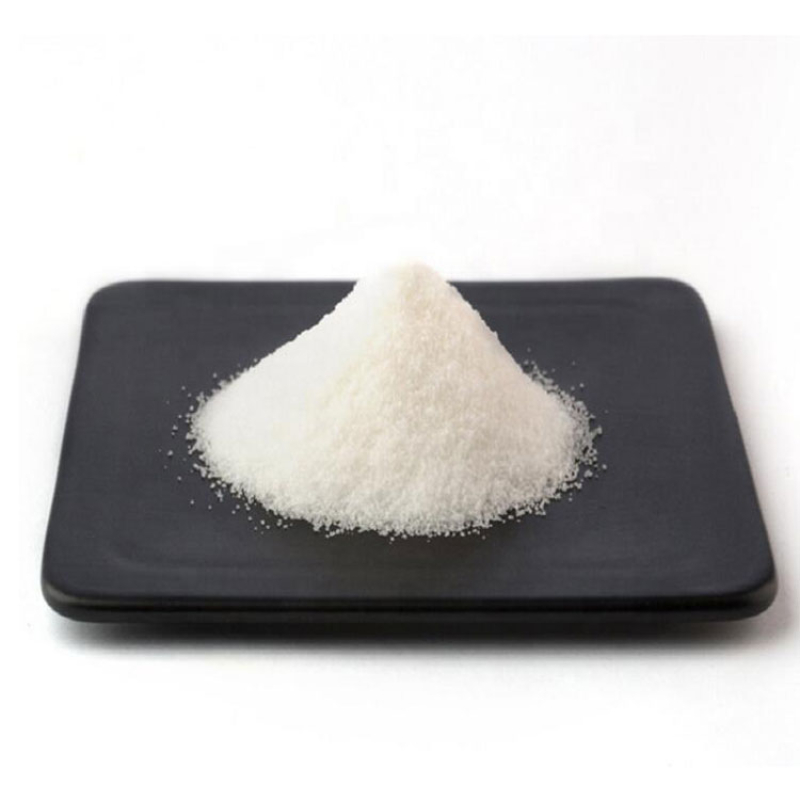Products Description of Tetrabutylammonium iodide CAS#311-28-4Tetrabutylammonium iodide (TBAI) is a commonly used phase transfer catalyst that can increase the reaction rate or effectively promote a variety of chemical reactions. This reagent can be used as an iodine source to generate the iodide required for the reaction in situ, avoiding the use of some unstable and expensive iodides.
Contact Now
Products Description of Cesium Iodide CAS#7789-17-5Cesium iodide, abbreviated as CsI, and inorganic halides including CsI(Tl) are widely used as scintillating media for high-energy particle and ionizing radiation detectors.
Contact Now
Products Description of Tetrabutylammonium Iodide COA#311-28-4Tetrabutylammonium iodide (TBAI) is a commonly used phase transfer catalyst that can increase the reaction rate or effectively promote a variety of chemical reactions. This reagent can be used as an iodine source to generate the iodide required for the reaction in situ, avoiding the use of some unstable and expensive iodides.
Contact Now
Products Description of Methyltriphenylphosphonium bromide CAS# 1779-49-3Methyltriphenylphosphonium bromide is a solid quaternary phosphonium salt flame retardant. At present, halogen-containing flame retardants are widely used organic flame retardants with excellent flame retardant properties. However, when a fire occurs, halogen-containing flame retardants will release a large amount of smoke and toxic hydrogen halide gas, causing secondary hazards.
Contact Now
Methyltriphenylphosphonium iodide Chemical PropertiesMelting point 183-185 °C(lit.)storage temp. Keep in dark place,Inert atmosphere,Room temperaturesolubility Chloroform (Slightly), Methanol (Slightly)form Powdercolor White to light yellowWater Solubility SOLUBLESensitive Light Sensitive & HygroscopicInChIInChI=1S/C19H18P.HI/c1-20(17-11-5-2-6-12-17,18-13-7-3-8-14-18)19-15-9-4-10-16-19;/h2-16H,1H3;1H/q+1;/p-1InChIKeyJNMIXMFEVJHFNY-UHFFFAOYSA-MSMILES[P+](C)(C1=CC=CC=C1)(C1=CC=CC=C1)C1=CC=CC=C1.[I-]CAS DataBase Reference2065-66-9(CAS DataBase Reference
Contact Now
Products Description of Potassium iodide CAS#7681-11-0 Potassium iodide is an ionic compound, in which iodine ions can form dark yellow precipitated silver iodide with silver ions (decomposed by light and can be used to make high-speed photographic film), so silver nitrate can be used to test the presence of iodine ions. As a component of thyroid hormone, iodine is closely related to the basal metabolism of livestock and poultry, and participates in almost all metabolic processes.
Contact Now
Products Description of Iodomethane CAS#74-88-4Methyl iodide is a halogenated hydrocarbon with the molecular formula CH3I, MeI. It is a monoiodine substitute of methane. The boiling point is 42.4℃, the relative density is 2.279 (20/4℃), it is a volatile liquid with high density at room temperature, the dipole moment is 1.59D, and the refractive index is 1.5304 (20°C, D), 1.5293 (21°C, D). Methyl iodide is miscible with common organic solvents, slightly soluble in water, soluble in ethanol and ether. The pure product is colorless and has a special odor.
Contact Now
Products Description of Thiourea CAS#62-56-6Thiourea, English name: Thiourea, white bright bitter crystal, soluble in cold water, ethanol, slightly soluble in ether, easily deliquescent in the air, and transforms into ammonium thiocyanate at 150°C. It has reducing properties and can reduce free iodine to iodide ions. Thiourea is highly reactive and is used to prepare various compounds.
Contact Now
Products Description of Ambroxane CAS#6790-58-5Ambroxan is one of the most important components of natural ambergris and has been identified in the aromatic components of ambergris tinctures. Ambroxan has a strong, rich ambergris aroma with mild woody notes. Very good fixative, fragrance with ambergris flavor, as a substitute for natural ambergris. Ambergris is a whale excrement found on beaches and is no longer used in perfume production for ethical reasons. Natural ambroxan is used in perfumes and was discovered in 1949.
Contact Now
Products Description of KERATINCAS#68238-35-7Fibrous protein produced by animal epithelial cells. It is the main component of hair, feathers, horns, nails, hooves, silk, etc., and has a protective effect on animals. It can be divided into two categories: one is α-keratin, such as the protein of hair, horns, nails, hooves, etc., which is rich in cystine in the molecule; the other is β-keratin, such as silk fibroin, which does not contain cystine and cysteine in the molecule, but has a high content of glycine, alanine and serine.
Contact Now
Products Description of Triethylene glycol dimethacrylate CAS#109-16-0Unsaturated polyester resin (UPR) is one of the three most widely used matrix resin materials in resin-based composite materials.
Contact Now
Chlorobenzene CAS# 108-90-7Chlorobenzene is a monocyclic fragrant compound with one hydrogen atom on the benzene ring substituted with one chlorine. It is produced by means of chlorination of benzene in the liquid segment with a catalyst. Chlorobenzene is a colourless, flammable liquid with a candy almond-like odor, at ambient temperature with a incredibly excessive vapour pressure, reasonable octanol-water partition coefficient (log 2.8) and average to low water solubility (497.9 mg/L @ 25℃).
Contact Now
DIOLEYL PHOSPHONATE CAS#64051-29-2Among various lubricants, dioleyl phosphonates can improve the anti-wear and load-bearing capacity of lubricants, reduce friction coefficient, lower equipment operating temperature, and improve equipment reliability and life. Adding to fuel can improve fuel combustion performance, reduce engine wear and carbon deposition, and reduce exhaust emissions.
Contact Now
Products Description of ChlorphenesinCAS#104-29-0Chlorphenesin is a preservative widely used in cosmetics and is compatible with most preservatives (including potassium sorbate, sodium benzoate, methylisothiazolinone). It is white crystals, usually with a weak characteristic odor. Melting point 77.0-80.5℃. Slightly soluble in water (about 0.5%). Solubility in 95% ethanol is 5%. Soluble in ethers. Slightly soluble in fixed oils, insoluble in white mineral oil. Microbial control performance: can provide improved broad-spectrum antibacterial activity.
Contact Now
Products Description of Diphenylacetonitrile CAS#86-29-3The molecular formula of diphenyl acetonitrile is C14H11N, and its melting point is 71-73°C. Boiling point 181 °C (12 mmHg). Flash point 120 °C. WATER SOLUBLE INSOLUBLE. Used as intermediates in organic synthesis.
Contact Now
Products Description of L-Histidine hydrochloride monohydrate CAS#5934-29-2White crystals or crystalline powder. Odorless. Slightly sour and bitter. Melts and decomposes at about 250% (after drying). Stable in nature. Aqueous solution is acidic (pH 3.5-4.5). Easily soluble in water (39g/100ml, 24℃), much more solubility in water than L-histidine. Insoluble in ethanol and ether. It is a quasi-essential amino acid (essential amino acid for infants and young children), and is synthesized slowly in the human body. Lack of it can lead to developmental delay, eczema and other symptoms.
Contact Now
Products Description of 6-bromo-1,2,3,4-tetrahydroisoquinoline CAS#226942-29-66-bromo-1,2,3,4-tetrahydroisoquinoline is a solid chemical with a CAS number of 226942-29-6. 6-bromo-1,2,3,4-tetrahydroisoquinoline Chemical PropertiesBoiling point 283℃density 1.428Fp 125℃storage temp. under inert gas (nitrogen or Argon) at 2–8 °Cpka9.26±0.20(Predicted)form SolidCAS DataBase Reference226942-29-6Product Application of 6-bromo-1,2,3,4-tetrahydroisoquinoline CAS#226942-29-66-Bromo-1,2,3,4-tetrahydroisoquinoline is only used for scientific research.Fact
Contact Now
Products Description of Tetrahydrothiopyran-4-one CAS#1072-72-6Tetrahydrothiopyran-4-one (4H-Thiopyran-4-one,tetrahydro-), the molecular formula is C5H8OS.Tetrahydrothiopyran-4-one Chemical PropertiesMelting point 60-64 °C (lit.)Boiling point 140.82°C (estimate)density 1.050 (estimate)refractive index 1.5100 (estimate)storage temp. Inert atmosphere,Room Temperaturesolubility Acetonitrile (Slightly), Chloroform (Slightly)form Crystalline Solidcolor White to pale yellowBRN 106464InChIKeyOVRJVKCZJCNSOW-UHFFFAOYSA-NLogP0.490 (est)CAS DataBase Refer
Contact Now
Products Description of Diantimony trioxide CAS#1309-64-4 Antimony trioxide is an inorganic compound with the chemical formula Sb2O3. The natural product is called antimony white, commonly known as antimony white. It is a white crystalline powder with a melting point of 655℃ and a boiling point of 1550℃. It is soluble in concentrated hydrochloric acid, sulfuric acid, alkaline solution and hot tartaric acid solution, slightly soluble in water, dilute nitric acid and dilute sulfuric acid.
Contact Now
Products Description of POLYGLYCERYL-4 LAURATE CAS#75798-42-4Colorless liquidFactory and Equipment ShowFast delivery timeInventory 2-3 working days New production 7-10 working days
Contact Now
Products Description of 4-Chloromethyl styrene CAS#1592-20-74-Vinylbenzyl chloride is an organic compound with the formula ClCH2C6H4CH=CH2. It is a bifunctional molecule, featuring both vinyl and a benzylic chloride functional groups. It is a colorless liquid that is typically stored with a stabilizer to suppress polymerization.In combination with styrene, vinylbenzyl chloride is used as a comonomer in the production of chloromethylated polystyrene. It is produced by the chlorination of vinyltoluene.
Contact Now
Products Description of Octadecanamide CAS#124-26-5Stearamide emulsion is a white emulsion. The product is non-toxic, non-polluting, non-hazardous and green and environmentally friendly.
Contact Now
Products Description of 1,3-Dihydroxyacetone CAS#96-26-4Dihydroxyacetone is a naturally occurring ketose that is biodegradable, edible and non-toxic to the human body and the environment.
Contact Now
Products Description of Sesamol CAS#533-31-3Sesamol, also known as 3,4-methylenedioxyphenol, is a fat-soluble lignan compound. It is an important component of sesame oil and an important quality stabilizer for sesame oil. Sesamol is present in sesame seeds, sesame oil and sesame meal, and can be continuously decomposed by sesamelin during thermal processing. The highest concentration in sesame oil can reach 64.4 mg/(100 g).Sesamol has a very strong antioxidant capacity and has been proven to have anti-inflammatory and intestinal function regulating effects.
Contact Now































